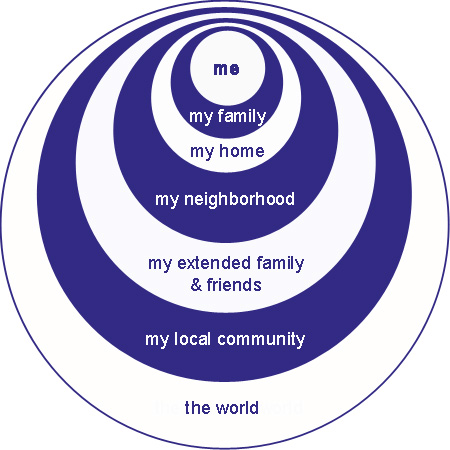Ripples: A Child in the World
Thinking of a young child discovering their place in the world reminds me of ripples spreading out from a stone dropped into water.
There is much we can do as parents and teachers to support our children as they grow to find a secure place for themselves within each of these ripples. Some initial thoughts…
Being me: providing children the opportunity to exercise choice and a developmentally appropriate degree of independence.
My immediate family: loving your child and responding to their needs quickly, instinctively and gently assist the development of both moral and prosocial behaviours.
My home: consider the impact your home has on a child’s five senses, as well as their sense of security and emotional well being.
My neighborhood: take your baby, toddler or child out walking (bike riding, scooting) through your neighborhood, greet you neighbours as you pass. Watch a local sporting match, visit your local fresh produce market or take part in a community event. Get to know your local parks and green spaces.
My extended family and friends: value the time you have with extended family and friends, especially when it comes to the traditions you share. Model to your child the importance of caring for those who are ill, elderly or going through difficult times. Consider the memories you are making together as family.
My local community: get out as a family into your wider community. Catch a bus or a train, visit a museum or a gallery, attend a regional fair, head out for a bushwalk; take advantage of all your community has to offer.

“Our identity is also formed by our relationship with the place we inhabit, our community.”
Landscapes of Possibility Conference, Reggio Emilia Australia Information Exchange, 2007
I would love to hear your thoughts on how our relationships, our spaces and our communities impact upon the developing identities of our children. How can we take advantage of these influences to support our children to become secure within themselves and within their world?


Lots to think about there – rich ideas indeed! I've just posted about the way my children (and myself as a child) connect and interact with natural places, something I'm interested in at the moment.
Since having children I've got to know our neighbours – it's been amazing really and given that our entire extended family is in another state, I'm so thankful for my small but wonderful mum's group. Those 4 families have become like extended family for us.
Also we go to the farmers' market every Sunday – a lovely ritual.
The circle image you use with the different levels of relationships rippling out is very similar to one we use in therapy withour girls.
Each circle is a different level of appropriate physical and emotional contact.
Mum + Dad + Siblings
Extended Family
Friends
Teachers
Aquantances etc
So with family it is okay to hug and kiss but with friends we would just give a quick hug or shake hands. With teachers we only shake hands.
Annie grasped this concept very well. Heidi still likes to hug everyone or hit them on the head with whatever object she wishes to show them.
Heidi's school runs a monthly farmer market and it has been really fabulous going to that. We saw the girls 4yo PreSchool teacher there 🙂 We found some honey called 'Heidi Honey Hurstbridge' – can't get better than honey with your own name own name on it!
Lovely thoughts.
My husband and I have always taken our daughter along to community meetings and gatherings. i think its important for her to see us as contributing members of our community. She loves going along and seeing familiar faces.
Public transport is another great way of encouraging confidence, connection and independednce.